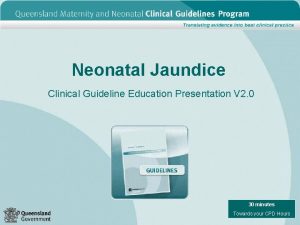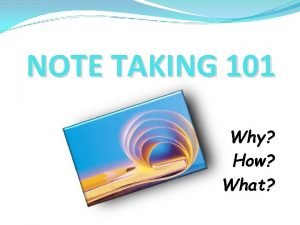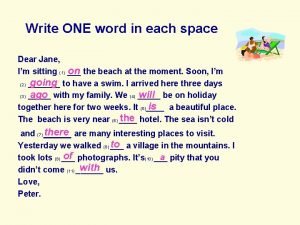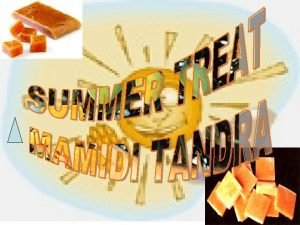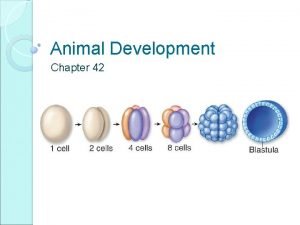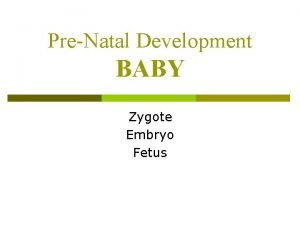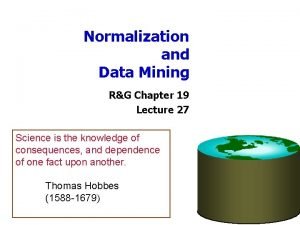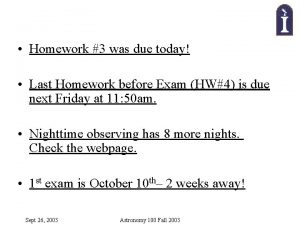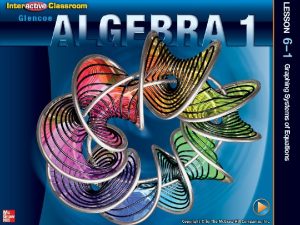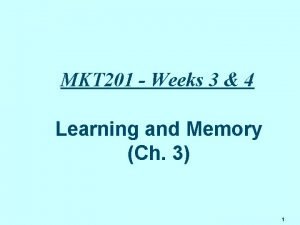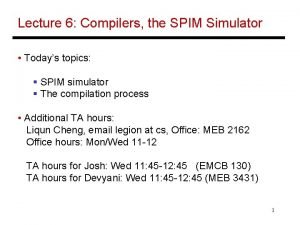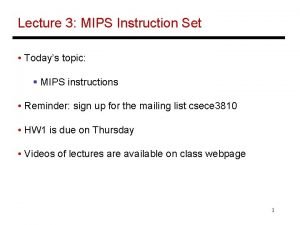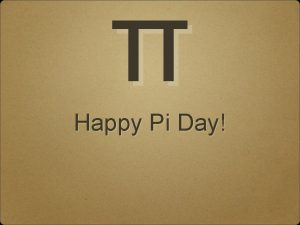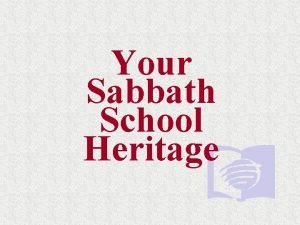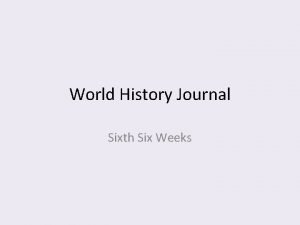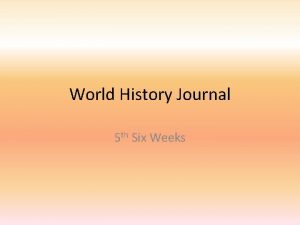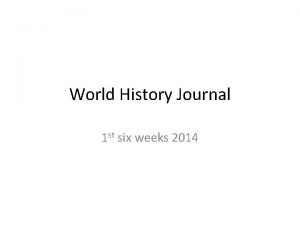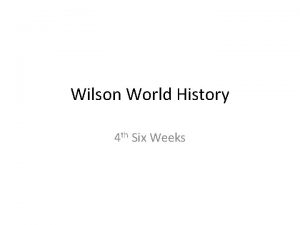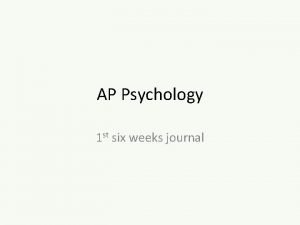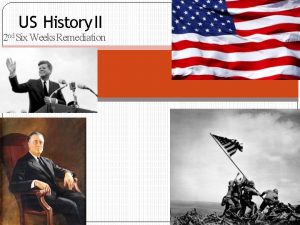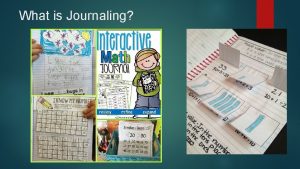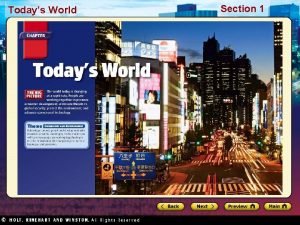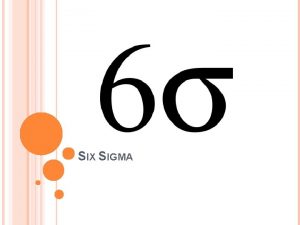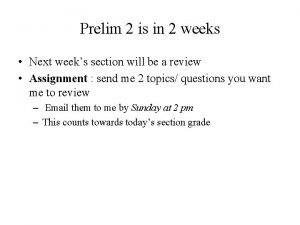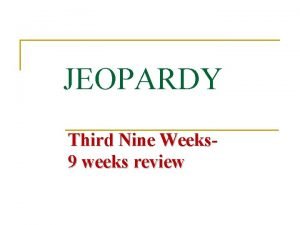World History Journal 1 st Six Weeks Todays









































- Slides: 41

World History Journal 1 st Six Weeks

Today’s Lesson Monday August 22, 2016 • Hello! • Note home to parents due August 29 • Daily journal • “Eras of My Life” assignment due August 29 • Writing a timeline • Prehistory

Write in your World History Journal 1. Write your name and class period on the cardboard back of the spiral notebook. 2. Make a cover page on the first sheet with your name and class period. 3. Use a whole page for each day’s journal: a. Journal entry b. 3 -5 Vocabulary terms. Write short (4 -6 word) definitions for each term. c. A graphic organizer, timeline, or drawing as instructed.

Journal entries For each journal entry: 1. Write the date in the top right corner of the entry. 2. Write the topic of the day. 3. If indicated, write assignment due dates or exam dates. 4. Answer the journal question in complete sentences, explaining your answers. 5. Write your own answers. You can discuss the topic, but do not copy others’ work.

1 Today’s Lesson 8/22 & 8/23 • Journal Warm-up: Technology • Today’s Topic: Neolithic Era • Eras of my life assignment • Today’s vocabulary terms • • • Artifact p. 6 Culture p. 7 Anthropology p. 7 Archeology p. 7 Technology p. 8 • Graphic organizer: marking a timeline. BCE/ CE or BC/ AD

Warm-up August 22 & 23 Read “Learning About our Past. ” Answer the prompts in sentences: • How are these tools technology? • What modern day tools do these resemble? to make a spear Image source: http: //www. unil. ch • TEKS (27) Science, technology, and society. The student understands how major scientific and mathematical discoveries and technological innovations affected societies

Today’s Lesson 8/24 A & 8/25 B • Journal Entry • Today’s topic: The Beginnings of Agriculture • Graphic organizer activity: Catal Hüyük reading • Vocabulary: 1. 2. 3. 4. 5. Paleolithic p. 11 Nomads p. 11 Animism p. 12 Neolithic Revolution p. 12 Domesticate p. 12 • Otzi the Ice Man • Neolithic Revolution Technology: Learning to use Pearson Realize 2

Graphic Organizer: Catal Hüyük Use the text on page 13 and the handout. Characteristic Who lived there? How many people? What was their economic base? Where was Catal Hüyük? When did this begin and end? How did they worship? In Catal Hüyük

Graphic Organizer: Catal Hüyük Use the text on page 13 and the handout. Characteristic Who lived there? How many people? What was their economic base? Where was Catal Hüyük? When did this begin and end? How did they worship? In Catal Hüyük

Journal Prompt Wednesday 8/24; Thursday 8/25 • PROMPT: (Write in complete sentences. ) • Before agriculture developed, how did people get food? • How would life be different if agriculture never developed? Learning Objectives: • Identify major causes of the development of agriculture • Summarize the impact of farming (Neolithic Revolution) on the creation of river valley civilizations.

3 Today’s Lesson; B day Friday 8/26; A day 8/29 Today’s topic: Civilization at Ur in Sumer Journal prompt: Writing Vocabulary: 1. 2. 3. 4. 5. 6. 7. Traditional economy p. 16 Civilization p. 17 Theocracy p. 18 Polytheistic p. 18 Scribes p. 19 City-state p. 20 Empire p. 20 Graphic organizer: Venn diagram comparing river valley and highland civilizations Activity: Poster of hunter/gatherer lifestyle or early civilization

Journal prompt: B day Friday 8/26; A day 8/29 Journal prompt Early Sumerian Pictographic Tablet about 3100 B. C. In what ways would our society today be different if we did not have writing? What would be the same? Image source: whenintime. com

Compare and Contrast: page 17 Complete the Venn diagram to compare and contrast civilizations that began in river valleys and those that began in highlands areas in the Americas.

Section 3 Civilization CASE STUDY: Ur in Sumer Prosperous farming villages, food surpluses, and new technology lead to the rise of civilizations. Buried Alive NEXT

Today’s lesson August 30 (B)/ 31 (A) • Today’s topic: Mesopotamia • Journal Prompt Hammurabi’s code • Graphic organizer: Sumerian social hierarchy p. 34 • Vocabulary terms 1. 2. 3. 4. 5. Ziggurat p. 34 Cuneiform p. 35 Civil laws p. 38 Criminal laws p. 38 Hittites p. 39 Worksheet: Empires in Mesopotamia Epic of Gilgamesh 4

Social Rank in Sumer p. 34

The Hammurabi stele was placed in a public place in Babylon where everyone could see it, though few were literate. It was later stolen by the Elamites. The British recovered the stele in Iran in 1901 and it is not on exhibit at the Louvre Museum in Paris. By Mbzt - Own work, CC BY 3. 0, https: //commons. wikimedia. org/w/index. php? curid=16931676

Journal prompt August 30 (B)/ 31 (A) What should be done to the carpenter who builds a house that falls and kills the owner? Eric Lessing/Art Resource, NY Learning Objective WH (20) Government • Identify the impact of political and legal ideas contained in documents including Hammurabi’s Code. • Hammurabi, the king of Babylon in about 1790 B. C. , made decisions which became laws and part of Hammurabi’s Code. • Based on your idea of “fairness” and modern day laws, explain what you think should happen in each case. Prompt: Ancient Mesopotamian carving of a carpenter at work.

Today’s Lessons 9/1 (B) 9/2 (A) 5 Journal prompt: Money economy • Today’s Vocabulary 1. Bureaucracy p. 41 2. Zoroaster p. 42 3. Colony p. 43 4. Alphabet p. 43 Graphic organizer/ drawing: Write your full name (first and last) in the Phoenician alphabet. Use the chart copy. • Write from right to left. • For missing letters, exchange another letter or use a dot.

Journal prompt: 9/1 (B) 9/2 (A) Journal Prompt: Answer all questions. • What advantages does a money economy offer over a barter economy? • Give an example of a modern transaction made easier by money instead of barter. • When might barter be used? (17) Economics. The student understands the impact of the Neolithic revolution on humanity.

Rise of the Persian Empire Analyze Maps Study the locations of the Persian capitals. Were they well placed for rule over the entire empire?

6 Today’s Lessons 9/6 (B) 9/7 (A) FIRST Journal Quiz. 11 Questions from the vocabulary, graphic organizers and journal prompts. SECOND Journal Lessons of the Day Topic: Hebrews Journal prompt: Ten Commandments Today’s vocabulary: 1. 2. 3. 4. 5. 6. Monotheistic p. 44 Torah p. 44 Covenant p. 45 Patriarchal p. 47 Ethics p. 47 Diaspora p. 48 Graphic Organizer: “Sequence It”

The Ancient Israelites’ Unique Belief System Analyze Maps: What factors may have led to Canaan's becoming a crossroads in the ancient Middle East?

Torah in Hebrew means “teaching” or “guidance”. The Torah includes the first five books of the Hebrew Bible: Genesis, Exodus, Leviticus, Numbers, and Deuteronomy.

The Hebrew Bible: “I am the LORD thy God, who brought thee out of the land of Egypt, out of the house of bondage. Thou shalt have no other gods before Me. ” —Exodus 20: 2 -3 • What does this quotation from the Hebrew Bible say that God did for the ancient Israelites? What does God demand in return? • What idea in this quotation refers to a belief that is different from most other cultures in the Fertile Crescent that you have read about in earlier lessons?

Journal Prompt: 9/6 (B) 9/7 (A) WH (3) Describe the major political , religious/ philosophical, and cultural influences of … Israel, including the development of monotheism, Judaism, and Christianity. WH (20) Identify the impact of the legal ideas in the Jewish Ten Commandments. Read the chart of the Ten Commandments. Prompt: Write two specific examples of the impact of the Ten Commandments on today’s society.

Law and Morality in Judaism Over time, the ideas in the Ten Commandments have influenced aspects of some modern legal and political systems.

Sequence it activity Origins of Judaism A. Put these key historical events and beliefs from the Jewish tradition into the correct chronological order, from earliest to latest. King Solomon completed Jerusalem’s temple. Moses brought the Israelites to Canaan. King Saul united the tribes of Israel into a nation. Abraham made a covenant with God. Many Jews from Judah were forced into exile during the Diaspora. B. Write 2– 3 sentences describing the central ideas of Judaism in your journal.

Law and Morality in Judaism Analyze Maps The Jewish Diaspora began with the Babylonian Captivity in 6 th century B. C. and has continued throughout history. How did the Diaspora contribute to the spread of Judaism?

7 Today’s Lesson 9/8 (B); 9/9 (A) Topic: Ancient Egypt Journal prompt: Sphinx Vocabulary: (beginning on p. 50) • Dynasty • Pharaoh • Vizier • Tutankhamen “King Tut” Graphic Organizer: Timeline of Egyptian Kingdoms Handouts: Reading: Tutankhamen Video: Seven Wonders of the World

Egyptian Kingdoms Create a timeline with these entries THREE MAIN PERIODS • Old Kingdom • Middle Kingdom • New Kingdom EVENTS • Building of the Pyramids • Peace treaty with the Hittites • Decline of Egypt’s power PEOPLE • Vizier Ptah-hotep • Hatsepshut • Thutmose • Ramses II • King Tutankhamen

Image source: Mc. Dougal Littell Inc Journal Prompt 9/8 (B); 9/9 (A) Shown above, this statue of a sphinx—a mythological creature having the body of a lion and the head of a man, ram, or hawk—is made of black granite. It represents Amenemhet III, a pharaoh who ruled in the Twelfth Dynasty of the Middle Kingdom. Compare the Sphinx of Amenemhet III to a statue honoring an important person in today’s society. • How are these monuments similar? • How are they different?

Today’s Lessons 9/12 A; 9/13 B Topic: Ancient Egyptian Culture Journal prompt: Hatshepsut Vocabulary pages 54 -58 I. Religion • Amon-Re • Isis • Osiris • Mummification II. Egyptian Learning Advances • Hieroglyphics • Papyrus • Rosetta Stone 8 NOTICE: QUIZ NEXT CLASS (9/14, 9/15) Egyptian civilization Graphic organizer: Egyptian social hierarchy ACTIVITY: Begin “PERSIA” Chart comparing Mesopotamia and Egypt Assignment: Essay about legacy one full journal grade (see back of PERSIA chart

Journal prompt 9/12 A; 9/13 B WH (24) Culture. The student understands the roles of women, children, and families in different historical cultures. Image source: Metropolitan Museum of Art at http: //metmuseum. org/exhibitions/listings/2006/hatshepsut Watch the video on Pearson Realize. • What about Hatshepsut was unprecedented in Egyptian history? • What does Hatshepsut's story reveal about the dangers of over -generalizing about history?

Egyptian Social Hierarchy p. 56

Egyptian Culture • mummy maker • Rosetta Stone • Image source: bbc. co. uk

Egyptian Learning Advances Analyze Information In 332 B. C. , the Greek ruler Alexander the Great conquered Egypt. According to the information on the chart, how was Egyptian knowledge passed along to other cultures?

Today’s Lesson A Day 9/14; B Day 9/15 • Vocabulary Quiz on Egypt (daily grade) • Journal prompt: Writing assignment 10 journal points • PERSIA comparison chart (daily grade) 9

Journal Prompt Writing Assignment A Day 9/14; B Day 9/15 Journal is due A day 9/19; B day: 9/20 • As you complete your study of ancient Middle Eastern civilizations and their influence on later civilizations, take a few minutes to reflect on all that you have learned. Think about • • • Cultures Governments Religions Scientific advances Economic ideas • Choose three elements you feel have the greatest influence on us today. • In your journal, on a fresh page, write a five paragraph essay about these elements. You may hand-write or type this assignment. Attach it to your journal, and turn it in with the journal on the due date. • Style • Introduction • A paragraph to describe the influence of each element you chose. • Conclusion

10 Today’s Lesson B day 9/16; A Day 9/19 TURN IN JOURNAL AFTER THIS ENTRY! • Topic: Indus Valley Civilizations Journal prompt: Hymns from the Rig Veda Vocabulary begins on page 71. 1. Harappa and Mohenjo Daro 2. Veneration 3. Acculturation 4. Aryans 5. Vedas 6. Rajah Graphic Organizer: Draw the structure of Aryan society using the body of Purusha (p. 74).

Journal prompt B day 9/16; A Day 9/19 Culture (B) analyze examples of how art, architecture, literature, music, and drama reflect the history of the cultures in which they are produced. Image source: wikimediacommons. The image depicts “Rig Veda” written in Sanskrit. Verses from the Vedas continue to be recited during Hindu celebrations such as weddings and religious prayers, making it probably the world's oldest religious text in continued use. Source: Wikipedia. Take turns reading the hymns “To Dawn” and “To Night” aloud. Journal Prompts: a. What did Aryans ask of each goddess? b. Which lines best convey the traits and qualities possessed by each goddess? Art Bonus (Optional) Draw and color a mini-poster of Dawn or Night based on your reading of the hymn.
 Chapter 13 marketing in today's world worksheet answers
Chapter 13 marketing in today's world worksheet answers Ap world history chapter 25 africa and the atlantic world
Ap world history chapter 25 africa and the atlantic world Dangerous world tour history world tour - hockenheimring
Dangerous world tour history world tour - hockenheimring A polygon with six congruent sides and six congruent angles
A polygon with six congruent sides and six congruent angles Antarctic journal four months at the bottom of the world
Antarctic journal four months at the bottom of the world Words that rhyme with weeks
Words that rhyme with weeks Weeks of supply formula
Weeks of supply formula Weeks of supply formula
Weeks of supply formula 3 weeks pregnant ultrasound
3 weeks pregnant ultrasound Cough for 3 weeks
Cough for 3 weeks 5 to 6 weeks
5 to 6 weeks Four weeks prior to christmas
Four weeks prior to christmas Liquor in pregnancy
Liquor in pregnancy Bilirubin chart newborn
Bilirubin chart newborn Gestational age in weeks
Gestational age in weeks This week's lesson
This week's lesson According to walter pauk, 10 weeks after lecture
According to walter pauk, 10 weeks after lecture Bma bank holiday lieu days
Bma bank holiday lieu days Dear joan thanks for your letter
Dear joan thanks for your letter Flocabul
Flocabul Chittibabu and chinnababu live in atreyapuram town in
Chittibabu and chinnababu live in atreyapuram town in 8 weeks embryo
8 weeks embryo Covering letter for resignation
Covering letter for resignation Embryo fetus zygote
Embryo fetus zygote 3 weeks from today
3 weeks from today Shannon weeks
Shannon weeks Hagen poiseuille law
Hagen poiseuille law Iron core
Iron core How many weeks
How many weeks 3rd 9 weeks exam review chemistry
3rd 9 weeks exam review chemistry 201 weeks
201 weeks Youtube.com
Youtube.com 4 weeks before christmas
4 weeks before christmas Generations
Generations Todays class
Todays class Multiple choice comma quiz
Multiple choice comma quiz Todays worldld
Todays worldld Whats thermal energy
Whats thermal energy Todays globl
Todays globl Whats todays wordlw
Whats todays wordlw Todays plan
Todays plan Todays sabbath lesson
Todays sabbath lesson













